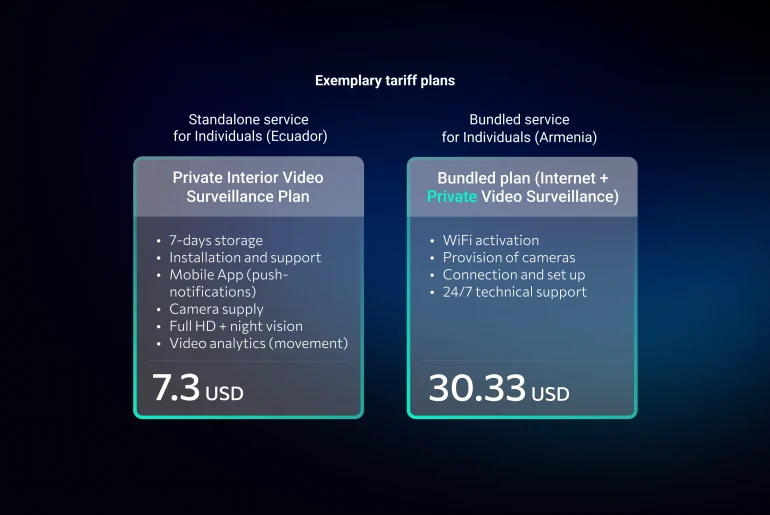There is no universal formula for creating tariff plans for video surveillance as a service for Telcos and ISPs. The right pricing model should align with a provider’s business objectives, pricing strategy, and regulatory environment in which they operate.
Drawing from our extensive experience working with telcos and ISPs, we’ve identified several critical factors that should inform the development of a robust and flexible VSaaS tariff plan.
Step 1: Main Factors Influencing Video Surveillance Tariff Formation
1. Camera Resolution
The resolution of cameras significantly impacts both the quality of surveillance and the infrastructure required to support it. Higher resolution cameras (e.g., 4MP, 5MP, or 4K) provide clearer images but also require:
- More bandwidth. Increasing network load, especially for live streaming.
- Greater storage capacity. High-definition footage consumes storage at a much faster rate.
- Higher processing power. For real-time analytics and playback.
These technical demands justify a premium price point, and providers often tier their plans based on resolution to match customer needs with system capabilities. Entry-level plans might offer 720p or 1080p resolution, while enterprise packages can scale up to 4K.
2. Type of Cameras
Different environments require different camera types, which affects cost:
- Fixed Dome Cameras. Ideal for indoor installations and discreet setups. Typically more affordable and easy to install.
- Bullet Cameras. Suited for outdoor use, offering long-range visibility and deterrence through visibility.
- PTZ (Pan-Tilt-Zoom) Cameras. High-end option with remote control, zoom, and tracking capabilities – best for large areas like parking lots or industrial sites.
- Specialty Cameras. Includes thermal, license plate recognition (LPR), or AI-enabled cameras that detect unusual behavior.
Providers should differentiate pricing based on hardware complexity and use-case scenarios.
3. Archive Depth
Archive depth refers to how long recorded footage is stored and available for playback or investigation. Common storage options include:
- 3-day storage: suitable for basic monitoring needs.
- 7–15 days: ideal for SMEs or customers with moderate security needs.
- 30 days or more: required by enterprises, law enforcement contracts, or regulatory mandates.
Longer retention increases cloud storage costs and backup requirements, thus raising the price. Providers can offer flexible plans where customers select their preferred retention duration.
Step 2: Additional Pricing Considerations for Video Surveillance Tariff
1. Subscriber Recording Capabilities
Some users, especially in business environments, may want the ability to:
- Download or archive footage locally.
- Upload footage to external or hybrid storage (e.g., NAS, external HDD, or enterprise cloud).
- Create backup copies for legal or audit purposes.
These capabilities increase the service’s value and should be offered as optional features or higher-tier plan benefits.
2. Camera Installation and Setup
Initial installation can vary widely in complexity depending on: site accessibility, number of cameras, wiring and power requirements, integration with existing systems.
Providers should consider offering:
- Self-install kits for budget-conscious customers.
- Professional installation packages, with tiered pricing based on service level (e.g., Basic, Advanced, Premium).
- On-site support or maintenance as part of SLA-based contracts for enterprise clients.
3. Equipment Rental
Offering cameras and storage equipment as part of a rental package helps:
- Reduce upfront costs for customers, accelerating adoption.
- Create predictable revenue streams through monthly or yearly contracts.
- Ensure device lifecycle control, allowing for timely upgrades and reduced support issues.
Providers can design tariff options that include “Hardware-as-a-Service” (HaaS) pricing models, especially for small businesses and startups.
4. Video Walls and Multiscreen Access (Primarily B2B)
Enterprise customers, particularly in retail, manufacturing, transportation, or public safety sectors, often require:
- Centralized monitoring dashboards.
- Multiscreen capabilities to view multiple locations or zones simultaneously.
- Integration with alarm systems or building automation tools.
These features can be marketed as value-added services and bundled into custom enterprise plans or charged as modular add-ons.
Step 3 – Choosing the Right Video Surveillance Tariff Model
Video surveillance services are highly adaptable and can be marketed either as independent products or bundled with other value-added services (VAS) and core connectivity solutions. Selecting the appropriate tariff model depends on the customer profile, the provider’s capabilities, and the desired business outcomes.
1. Standalone VSaaS Model
In this setup, the surveillance service is offered on its own – completely focused on delivering core features like camera feeds, remote access, and cloud-based recording without any integration into other services. Example of customers: residential users, small offices and independent businesses without complex IT infrastructure
Exemplary use cases of tariff plan for Individuals from Ecuador
Interior surveillance
Price: $7,3
What includes:
- 7-days storage
- Installation and support
- Mobile app (push notifications)
- Camera supply
- Full HD + night vision
- Video analytics (movement)
Exterior surveillance
Price: $10,3
What includes:
- Video analytics
- H.265 codec support
- 7-days storage
- Full HD + night vision
- Camera supply
- Installation and support
This model works well for customers who want minimal complexity and are focused solely on video monitoring without extra integrations.
2. Bundled VAS Based on Video Surveillance
In this more advanced model, VSaaS is packaged with complementary smart services such as intercom systems, facial recognition, access control, and video analytics to offer a more holistic security solution. Example of customers: enterprise clients, real estate developers, residential communities, educational and healthcare institutions.
Example Use Cases of bundled VAS tariff plan for Individuals and Businesses from Pakistan
Price: $2,97
What includes:
- Connection of 2 cameras to the service ($1,37 for each new camera)
- Access to the smart intercom
- Access to mobile app
Additional:
- Installation per camera – $5,57
- Provisioning of HD IP Camera – $38,57
- Provisioning of HD IP Camera with Audio Feature – $51,29
This model appeals to clients looking for intelligent environments rather than just raw surveillance footage.
3. Bundled VSaaS with Core Telco Services
This model integrates video surveillance directly with telco offerings like internet, mobile plans, or fixed-line services. Telcos benefit from existing infrastructure, while customers appreciate simplicity, unified billing, and better performance. Example of customers: residential broadband customers, small and medium businesses (SMBs), multi-site franchises.
Exemplary use cases of bundled tariff plan for Individuals (internet + video surveillance) from Armenia
Price: $30,33
What includes:
- WiFi activation
- Provision of cameras
- Connection and set up
- 24/7 technical support
This bundled approach is particularly attractive to telcos looking to reduce churn, drive ARPU (Average Revenue Per User), and deepen customer relationships.
*One more tip: when offering public access to video surveillance (such as cameras in shared areas), the cost can be structured as 15–20% of the most popular internet plan.”
Final thoughts on Video Surveillance Tariff Plan
There are only generalised examples. The design of successful video surveillance tariff plans in today’s fast-changing security environment requires both artistic and scientific approaches. The successful implementation of VSaaS requires technical features to match customer needs and business objectives through hardware selection and storage depth and bundling strategies and installation services. The current market demands telcos and ISPs to redesign their video surveillance service pricing models to boost ARPU and explore new revenue opportunities.
Are you prepared to develop VSaaS tariff models that will last into the future? Our team of experts will assist you in forming business model for value-added services based on video surveillance which deliver value and customer satisfaction and sustainable growth.





